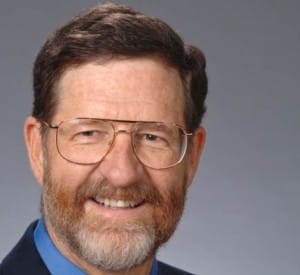
In January, 1975, Rick moved from Arizona to the frigid north to pursue graduate studies in analytical chemistry under an NSF graduate fellowship at Michigan State University, focusing on electronics and computerized instrumentation. Together with Professor Chris Enke, he conceived of the computerized tandem quadrupole mass spectrometer for analytical MS/MS studies. Although their proposal to NSF was not persuasive enough to convince the reviewers that such an instrument was viable or analytically useful, Dave Nelson of the Office of Naval Research invested in the proposed research. A couple thousand pounds of stainless steel, aluminum, and electronics later, the instrument was taking form, when a chance meeting at the May 1977 ASMS Conference in Washington, DC, with Professor Jim Morrison of Australia’s LaTrobe University found unexpected support. Jim had constructed a similar triple quad instrument for laser spectroscopy of mass-selected ions, and invited Rick to spend a couple of months performing preliminary experiments on that instrument. Those experiments, combined with computer simulations of ion trajectories with SIMION (written by Jim and his graduate student Don McGilvery) were instrumental in the successful completion of the Michigan State instrument. The instrument was patented by Research Corporation for MSU; its importance has been recognized by the presentation to Rick and Chris of the 1993 ASMS Award for Distinguished Contribution to Mass Spectrometry. Over $20 billion of mass spectrometers have been sold worldwide based on this and other patents from his research group. Rick received his Ph.D. in the summer of 1979 and assumed the position of Assistant Professor at the University of Florida. Rick has risen through the ranks at UF to Professor and Head of the Analytical Chemistry Division. His research has involved 91 graduate students funded by nearly $4 million in research grants, and the publication of over 155 papers (link to recent publications). Also contributing to these research efforts have been a number of collaborators at UF and around the world, visiting scientists, plus undergraduate and high school researchers. Current research interests center on instrumental developments, fundamental studies, and analytical applications of tandem mass spectrometry and ion mobility, including imaging mass spectrometry.
Rick currently serves as a member of the Florida Board of Governors (Regents) and as the Chair of the Advisory Council of Faculty Senates of Florida. He is past Chair of the UF Faculty Senate and has served on the UF Board of Trustees. He has served as the Treasurer and Secretary of the American Society for Mass Spectrometry, and has served on the editorial boards of The Journal of the American Society for Mass Spectrometry and The International Journal of Mass Spectrometry. On the personal side, Rick married Katie Fitzgerald on June 16, 1979 (a week after his Ph.D. commencement exercises). As best friends and partners in life, we have enjoyed traveling around the world (before kids!) and raising a wonderful family – Sarah (BS in Biology from Furman University), Mike (Environmental Sciences major at Florida Institute of Technology) and Matt (Anthropology major here at UF). We all enjoy school, Scouting, traveling, hiking, and swimming.